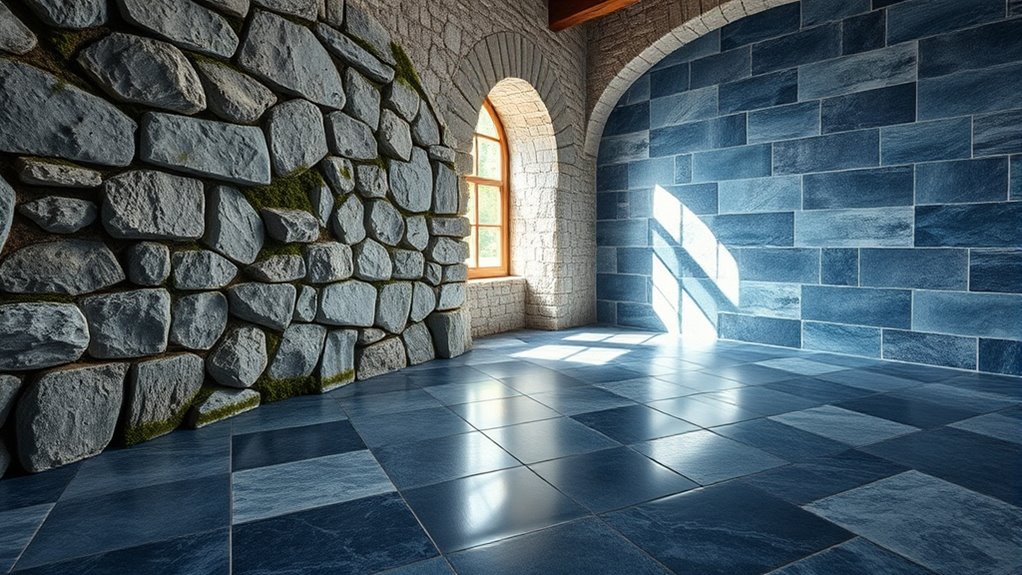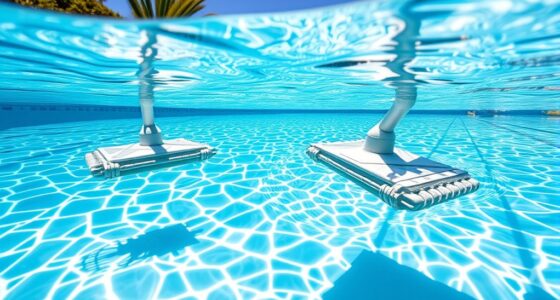From castle walls to modern tiles, flooring has evolved markedly over centuries. Early civilizations used earth, mud, and stone for practicality, while artisans later crafted intricate wooden, marble, and terrazzo designs that showcased artistry and status. The Industrial Revolution introduced mass-produced materials and advanced installation systems, making sophisticated floors more accessible. Today, sustainable options and smart technology shape the future of flooring. Discover how this rich history continues to influence our spaces as you explore further.
Key Takeaways
- Early flooring consisted of earth, mud, and natural stones, primarily for insulation and stability in ancient civilizations.
- Fired clay tiles and intricate wooden floors with inlaid designs marked technological and artistic advancements during the Renaissance.
- The Industrial Revolution introduced mechanized production and engineered materials, enabling mass-produced, durable, and decorative flooring options.
- Modern innovations include sustainable materials like bamboo and reclaimed wood, along with advanced installation systems for durability and ease.
- Future trends focus on smart, eco-friendly, and customizable flooring solutions integrating technology and sustainable practices.
Early Foundations and Practical Materials

Early flooring primarily consisted of ground surfaces excavated into the earth, which were then covered with materials like mud, clay, or straw to provide insulation and stability. In ancient civilizations such as Mesopotamia and Egypt, they used natural stones, mud bricks, and compacted earth to create basic earthen floors. These materials represented practical solutions for durable flooring, relying on simple construction methods that guaranteed stability and longevity. Early flooring focused on functionality, with ground surfaces serving as the foundation for living spaces. Over time, construction techniques improved, allowing for more resilient and stable floors. The development of construction materials further enhanced durability, enabling the creation of more complex flooring systems. Additionally, the use of fire and kiln technology allowed for the production of fired clay tiles, which contributed to more sophisticated and durable flooring options in later periods. These practical materials laid the groundwork for more sophisticated flooring options in later periods, reflecting the ingenuity of ancient builders and their focus on durable, accessible construction methods. As technology advanced, the introduction of fired clay tiles and other fired materials marked a significant step toward more refined and long-lasting flooring solutions. Furthermore, innovations in kiln firing techniques improved the quality and variety of fired clay products, paving the way for decorative and functional floorings.
Artistic Innovations and Decorative Techniques

During the Renaissance and Baroque periods, artisans pushed the boundaries of flooring design by creating intricate parquetry patterns, such as herringbone and chevron, using small pieces of differently colored wood. These geometric patterns showcased artistic craftsmanship and advanced marquetry techniques, blending decorative inlay with artistic expression. Marqueterie became a popular method for adding detailed pictorial and decorative patterns directly onto floors. Additionally, terrazzo emerged as a durable, colorful surface, composed of marble chips embedded in cement, exemplifying innovative decorative techniques. These artistic innovations allowed floors to become more than functional surfaces—they became statements of wealth and creativity. By exploring these decorative techniques, artisans elevated flooring into a form of artistic expression, reflecting the evolving tastes and technological advancements of the era. The development of artistic craftsmanship in flooring demonstrated the integration of functional design with aesthetic appeal, setting new standards for decorative arts. Furthermore, the use of environmentally conscious materials in some flooring techniques highlighted an early awareness of sustainability, even in historical contexts. The incorporation of material innovation during these periods contributed to the durability and aesthetic versatility of flooring surfaces. Incorporating sound vibrations and other sensory elements into architectural design is also an evolving trend that continues to influence modern decorative techniques.
The Impact of the Renaissance and Baroque Periods
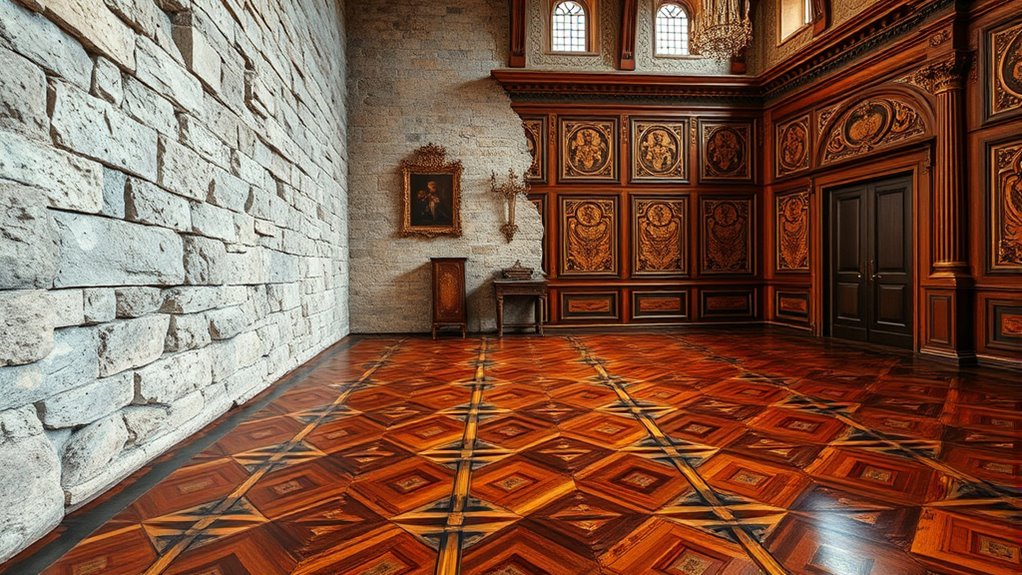
The artistic innovations of the Renaissance and Baroque periods transformed flooring from practical surfaces into symbols of wealth and cultural sophistication. During this time, intricate parquet flooring with geometric patterns like herringbone and chevron gained popularity in European palaces and noble residences, exemplified by the parquet de Versailles. Marble and terrazzo floors showcased artistic craftsmanship, serving as luxury flooring in historic buildings and emphasizing status. Skilled artisans created ornate wooden floors with detailed inlaid designs from different woods, reflecting the era’s grandeur. These styles spread across Europe, inspiring ornate stone and wooden floors that still adorn museums and churches today. The development of geometric patterns in parquet flooring highlighted craftsmanship and artistic mastery, and the use of sustainable materials became more prominent as artisans sought eco-friendly options. Additionally, the period saw an increased appreciation for artistic detail, which further elevated flooring from mere utility to an integral element of interior decor. Furthermore, the revival of classical motifs and cultural influences during this era contributed to the richness and diversity of flooring designs seen in historic architecture.
The Industrial Revolution and Technological Breakthroughs
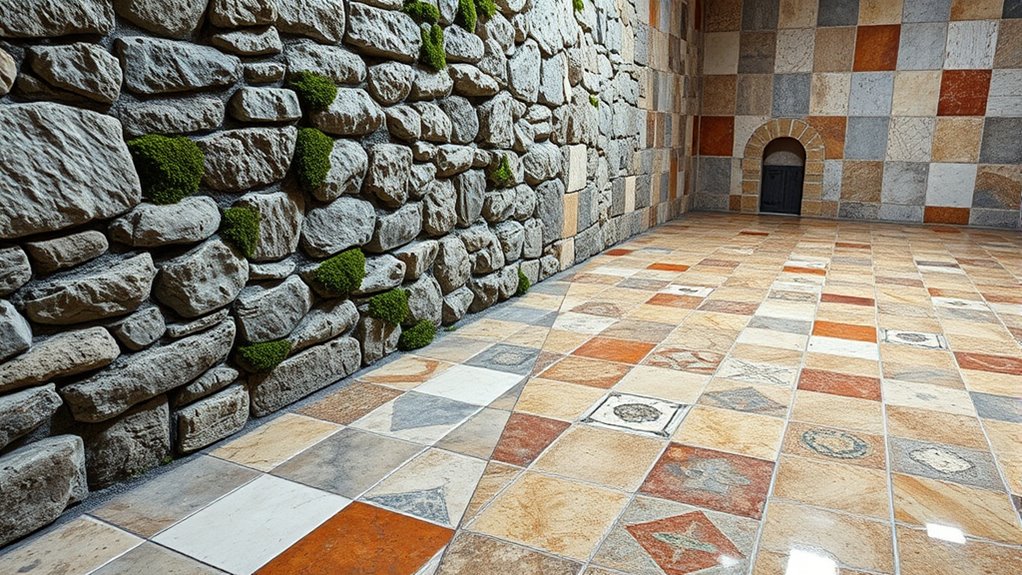
The Industrial Revolution brought groundbreaking technological advancements that transformed flooring production and installation. Mechanized sawmills and manufacturing advances increased efficiency and uniformity, enabling mass production of engineered wood and parquet flooring. Steam-powered machinery made intricate designs more affordable, broadening access. Installation systems like tongue-and-groove and click-lock simplified flooring installation, encouraging DIY projects and reducing the need for professionals. Pre-finished and laminated flooring emerged, offering durability and easier maintenance. These innovations expanded material options and aesthetic possibilities. The table below highlights key developments:
| Innovation | Impact | Material Example |
|---|---|---|
| Mechanized sawmills | Increased efficiency | Hardwood, engineered wood |
| Parquet flooring | Complex, affordable designs | Vintage, modern styles |
| Click-lock systems | Easier installation | Laminated, engineered floors |
| Pre-finished flooring | Faster, durable installation | Laminate, engineered |
Additionally, advancements in flooring adhesives and underlayments improved the longevity and stability of various flooring types. These innovations collectively made flooring more accessible, versatile, and durable for consumers. Furthermore, ongoing research into sustainable materials ensures that future flooring options will be both eco-friendly and innovative.
Modern Materials and Sustainable Choices
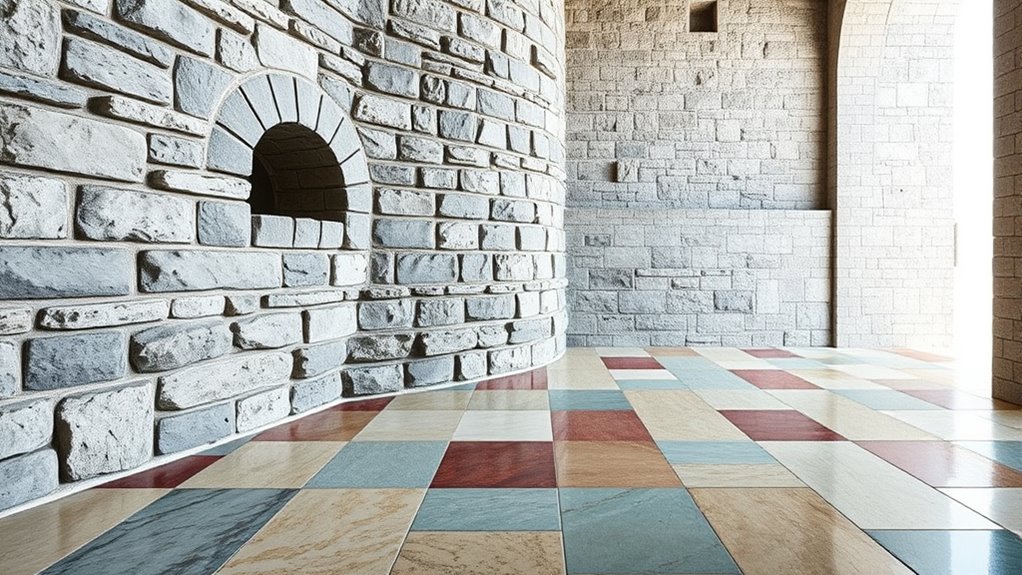
Modern flooring options now prioritize eco-friendly materials like bamboo, cork, and reclaimed wood, offering sustainable choices for your space. Advances in manufacturing have led to durable, low-VOC, and recyclable products that improve indoor air quality. Innovative installation techniques further enhance the practicality and environmental benefits of these modern flooring solutions. Additionally, the development of sustainable manufacturing processes ensures that these materials are produced with minimal environmental impact, supporting eco-conscious building practices. Incorporating renewable resources into manufacturing further reduces the carbon footprint of flooring materials, making them an even more sustainable option for environmentally aware consumers. The use of headphone technology in manufacturing can also improve quality control and material testing to ensure durability and safety. Implementing eco-friendly living practices in manufacturing processes enhances the overall sustainability of flooring products. Understanding material durability helps consumers choose long-lasting options that reduce waste and environmental impact.
Eco-Friendly Material Options
As homeowners seek sustainable options, eco-friendly flooring materials like bamboo, cork flooring, reclaimed wood, and recycled vinyl offer effective alternatives that minimize environmental impact. Bamboo, a rapidly renewable resource, matures in just 3-5 years, making it a popular sustainable material. Bamboo flooring is not only durable but also adds a contemporary aesthetic to modern homes. Bamboo’s fast growth rate and renewability exemplify renewable resources that support sustainable building practices. Cork flooring is harvested from cork oak trees without harming them, allowing continuous harvests and forest preservation. Reclaimed wood and recycled vinyl help reduce waste and lower the carbon footprint of your project. Many eco-friendly flooring options are manufactured with low-VOC adhesives and finishes, improving indoor air quality. These choices support green building practices by utilizing renewable resources and reducing harmful emissions, creating a healthier home while caring for the environment. Incorporating these sustainable materials ensures your space aligns with eco-conscious living. Additionally, choosing vetted products like the first home theatre projector ensures quality and durability in your eco-friendly upgrades.
Advances in Durability
Advances in flooring technology have markedly boosted durability through the development of high-resistance materials and innovative installation methods. Today’s materials, like reinforced composites and engineered wood, offer exceptional wear resistance and water-resistant qualities, ensuring long-lasting performance. Synthetic polymers now include UV stabilization and antimicrobial agents, extending lifespan and maintaining hygiene over decades. Sustainable options such as bamboo and reclaimed wood are engineered for strength while being eco-friendly. Modern installation systems, like click-lock mechanisms, reduce damage during setup and facilitate easy repairs, further enhancing durability. These innovations allow flooring to withstand heavy use and harsh conditions, making them ideal for both residential and commercial spaces. Ultimately, these advancements provide you with reliable, resilient flooring solutions that stand the test of time.
Innovative Installation Techniques
Innovative installation techniques have transformed how flooring is laid, making the process faster, easier, and more eco-friendly. With click-lock and floating floors, you can enjoy DIY-friendly installation that reduces time by up to 50%, often without adhesives. Sustainable options like cork and reclaimed wood use interlocking systems that minimize waste and simplify setup. Advanced adhesives and low-VOC underlayment improve indoor air quality and are environmentally conscious choices. Modular flooring planks allow quick, durable installations with minimal prep, often completed in a day. Additional innovations include integrated smart sensors and heated flooring systems, which are designed for seamless incorporation during installation, boosting home automation and comfort.
- Click-lock and interlocking systems for quick setup
- Floating floors that require no adhesives
- Low-VOC adhesives and eco-friendly underlayment
- Modular flooring for DIY-friendly, rapid installation
Future Directions in Flooring Design
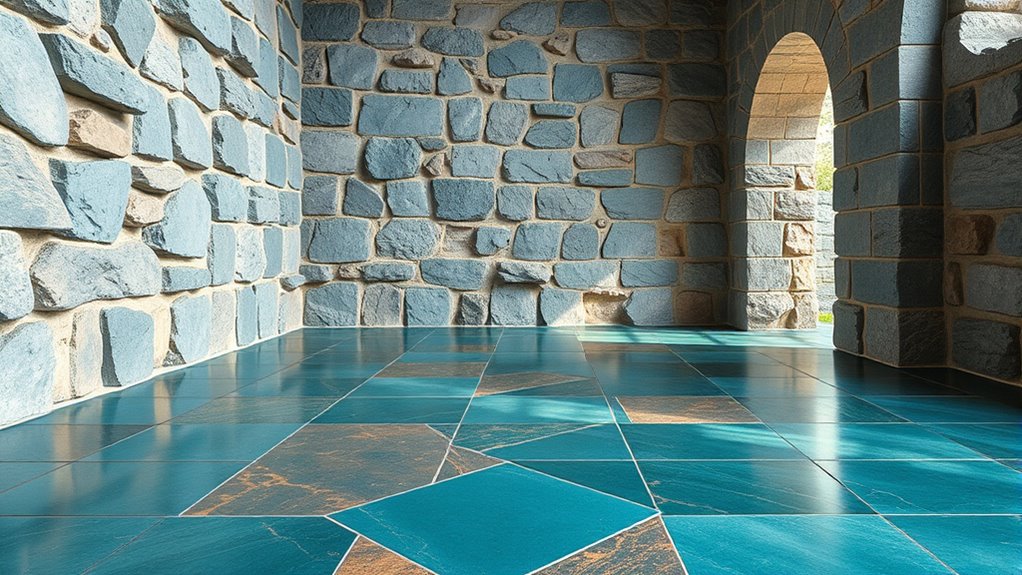
Future flooring design is set to embrace smart technology, integrating sensors that monitor temperature, moisture, and foot traffic to boost functionality. You’ll see more eco-friendly flooring made from sustainable materials like recycled plastics, bamboo, and cork, reducing environmental impact. Digital customization will allow you to create unique patterns and textures using innovative manufacturing techniques such as 3D printing. Waterproof, scratch-resistant coatings will extend the lifespan of your floors, making them more durable. Energy-efficient flooring solutions, including underfloor heating and smart systems, will enhance comfort and reduce energy bills. Modern tiles will continue evolving, blending aesthetic appeal with advanced features. Overall, future flooring design will prioritize sustainability, personalization, and technology, transforming your space into a smarter, greener, and more stylish environment.
Frequently Asked Questions
What Flooring Is Used in Castles?
You might wonder what flooring castles used. Typically, they relied on stone and brick for durability, especially in busy areas like halls and kitchens. In some chambers, wooden planks made from oak or pine were added for insulation and comfort. Wealthier castles showcased intricate mosaics or decorative tiles, reflecting their status. For insulation, floors often had earthen layers covered with rushes, straw, or wool mats to keep warmth and odors in check.
What Were the Flooring Trends in the 1950S?
In the 1950s, you’d notice a shift toward affordable, easy-to-maintain flooring options like linoleum and vinyl, which became popular in homes and commercial spaces. Brightly colored carpets, shag and plush styles, and patterned tiles also gained popularity, reflecting the vibrant interior design of the era. Terrazzo was common in public buildings, while wall-to-wall carpeting made homes feel cozier and more inviting, embodying the mid-century love for comfort.
What Is the New Style in Flooring?
You’re curious about the latest flooring styles. Today, you’ll notice large-format tiles with minimal grout lines creating a sleek, modern look. Sustainable materials like recycled porcelain and eco-friendly linoleum are trending. Smart options with sensors or underfloor heating are becoming popular. Matte finishes and natural textures, mimicking stone or wood, give a contemporary vibe. Biophilic designs with living plant-based floors or moss tiles are also gaining traction for eco-conscious aesthetics.
What Is the History of Flooring?
Imagine this: your floors have a fascinating history! You start with primitive dirt, clay, and stone, evolving through artistic mosaics of ancient Greece and Rome. Medieval floors used wooden planks and straw, while Renaissance craftsmanship crafted intricate parquet and marble. The Industrial Revolution then revolutionized flooring with linoleum and vinyl, making durable, decorative options accessible. Your modern floors are the result of centuries of creativity, craftsmanship, and technological transformation.
Conclusion
From sturdy castle walls to sleek modern tiles, flooring has evolved with your changing needs and dreams. While ancient materials offered durability, today’s innovative designs bring beauty and sustainability into your home. Imagine the contrast—your ancestors relied on simple stones, and now you have endless choices that reflect your style and values. Embrace this journey, knowing each step in flooring’s evolution connects you to a rich history while shaping the future you create beneath your feet.
